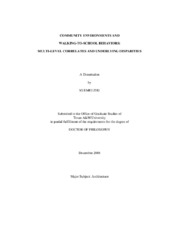| dc.description.abstract | Walking can be a safe, healthy, and affordable mode of school transportation.
However, most students today do not use walking for their school travel. More research
is needed to understand the correlates of walking to or from school and to identify
effective interventions.
This is a cross-sectional study of 73 public elementary schools in the Austin
Independent School District of Texas. The first phase used geographic information
systems and field audits to examine school-level disparities in the environmental support
for walking in schools’ attendance areas. The second phase involved surveys of students’
parents or guardians to identify the multi-level correlates of using walking as their
children’s typical school travel mode.
In the first phase, results from analyses of variance and linear regressions
indicated the existence of disparities. Lower economic status of student population was
associated with poorer street conditions (e.g., maintenance, visual quality, amenities, and
perceived safety), shorter distances to school, and lower traffic volumes. Higher
percentage of Hispanic students within a school was associated with increased danger from traffic and crime and more sidewalks, greater population density, and mixed land
uses.
The second phase used binary logistic regressions to predict walking to or from
school. Among the personal and social factors, parents’ education, car ownership,
personal barriers, and school bus availability were negative correlates, while parents’
and children’s positive attitude and regular walking habit and supportive peer influences
were positive correlates. Of the physical environmental factors, long distance and safety
concerns were the strongest negative correlates, followed by the presence of highways or
freeways, convenience stores, office buildings, and bus stops en route.
In conclusion, environmental interventions are needed to develop centrallylocated
neighborhood schools, barrier-free attendance areas, and well-maintained
pedestrian infrastructure. Disparities and fine-grained differences are found in the
environmental support for walking. A high priority for low-income, Hispanic children
and interventions tailored for specific contexts and populations appear necessary. Safety
improvement is indispensible in terms of both traffic and crime and should be
supplemented with educational programs that target both parents and children. Finally,
multi-agency collaborations are needed at the policy level to support and facilitate these
multi-level interventions. | en |


